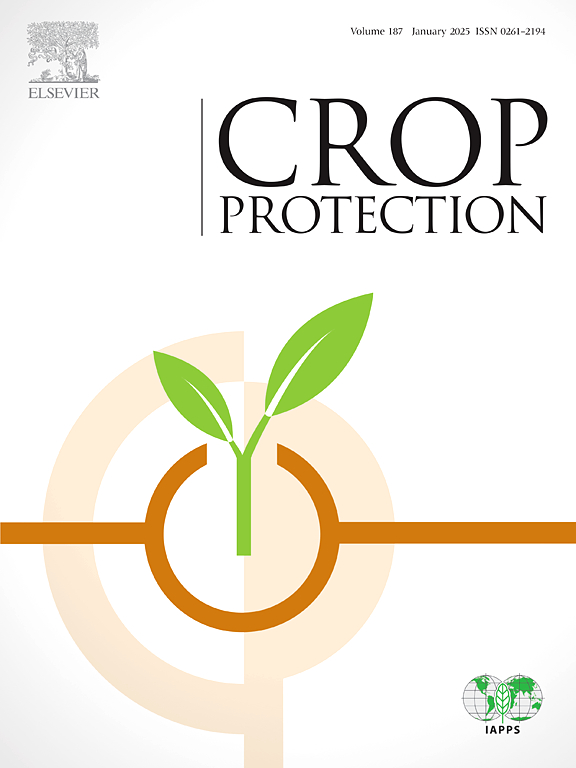Selectivity of pre-emergent herbicides in cassava (Manihot esculenta Crantz) and its relationship with the stem cutting planting system
IF 2.5
2区 农林科学
Q1 AGRONOMY
引用次数: 0
Abstract
Cassava (Manihot esculenta Crantz, Euphorbiaceae), an important source of food for millions of people in the world, is distributed mainly in Asia, Africa, Latin America, and the Caribbean. Weeds are important biotic constraints on cassava production, and herbicide application can provide effective weed control in this crop. However, the different possibilities of herbicide selectivity (factors associated and not associated with the plants) must be studied before implementation. The aim of this study was to evaluate the effects of the combination of different pre-emergence herbicides and two stem cutting planting systems (vertical and horizontal) on phytotoxicity and several agronomic traits of the cassava crop. The experiment was conducted through a factorial arrangement in a completely random design in Corrientes, Argentina. The factors studied were planting systems (horizontal and vertical position), weed control methods (hoeing or application of diuron, S-metolachlor, pendimethalin or clomazone, 625; 1920; 900 and 1000 g a.i. ha−1, respectively), and cropping seasons (2018–2019 and 2019–2020). The following variables were measured: phytotoxicity, plant height, relative plant stand, total weight of tuberous roots per plant, starch concentration of tuberous roots, and starch production per ha. The highest precipitations occurred in the 2018–2019 cropping season. The vertical planting system in combination with herbicides showed lower phytotoxicity values and higher values of plant height, starch concentration, and starch production per ha than the horizontal planting system. The highest phytotoxicity values were recorded with the application of diuron combined with the horizontal planting system and in the 2018–2019 season, with a 33.33% decrease in relative plant stand compared to the use of hoeing. Starch concentration remained unchanged with the use of clomazone and pendimethalin, whereas the effect of these herbicides on starch production varied with the cropping season, decreasing only in 2019–2020. Starch production was significantly lower with the use of S-metolachlor (up to 55.29% in 2018–2019) and of diuron (up to 60.57% in 2019–2020) than with the use of hoeing. In conclusion, phytotoxicity values were higher for the horizontal planting system than for the vertical system. The herbicide with the highest phytotoxic effect on the cassava crop was diuron; the effect increased when combined with the horizontal planting system in the cropping season with higher rainfall. This work provides the basis for integrated weed management concerning the use of herbicides and their selectivity according to planting systems for cassava crops.
木薯(Manihot esculenta Crantz)萌芽前除草剂的选择性及其与切茎种植系统的关系
木薯(Manihot esculenta Crantz,大戟科)是世界上数百万人的重要食物来源,主要分布在亚洲、非洲、拉丁美洲和加勒比地区。杂草是木薯生产的重要生物制约因素,施用除草剂可有效控制杂草。然而,在使用前必须研究除草剂选择性的不同可能性(与植物相关或无关的因素)。本研究的目的是评估不同的萌芽前除草剂和两种茎切割种植系统(垂直和水平)的组合对木薯作物的植物毒性和若干农艺性状的影响。试验在阿根廷科连特斯以完全随机设计的因子排列方式进行。研究的因素包括种植系统(水平和垂直位置)、杂草控制方法(锄草或施用噻草隆、S-甲草胺、戊唑醇或氯马宗,有效成分分别为 625、1920、900 和 1000 克/公顷)以及种植季节(2018-2019 年和 2019-2020 年)。测量了以下变量:植物毒性、植株高度、相对株高、每株块根总重量、块根淀粉浓度和每公顷淀粉产量。最高降水量出现在 2018-2019 年种植季。与水平种植系统相比,与除草剂结合的垂直种植系统显示出较低的植物毒性值,以及较高的株高、淀粉浓度和每公顷淀粉产量值。植物毒性值最高的是施用噻草隆与水平种植系统相结合的情况,并且是在 2018-2019 年种植季,与锄草相比,相对株高降低了 33.33%。使用氯马宗和戊唑醇后,淀粉浓度保持不变,而这些除草剂对淀粉产量的影响随种植季节而变化,仅在 2019-2020 年有所降低。使用 S-甲草胺(2018-2019 年高达 55.29%)和二嘧磺隆(2019-2020 年高达 60.57%)时,淀粉产量明显低于使用锄草时。总之,水平种植系统的植物毒性值高于垂直种植系统。对木薯作物植物毒性影响最大的除草剂是利谷隆;在降雨量较高的种植季节与水平种植系统结合使用时,植物毒性影响会增加。这项研究为木薯作物除草剂的使用及其根据种植系统的选择性提供了综合杂草管理的基础。
本文章由计算机程序翻译,如有差异,请以英文原文为准。
求助全文
约1分钟内获得全文
求助全文
来源期刊

Crop Protection
农林科学-农艺学
CiteScore
6.10
自引率
3.60%
发文量
200
审稿时长
29 days
期刊介绍:
The Editors of Crop Protection especially welcome papers describing an interdisciplinary approach showing how different control strategies can be integrated into practical pest management programs, covering high and low input agricultural systems worldwide. Crop Protection particularly emphasizes the practical aspects of control in the field and for protected crops, and includes work which may lead in the near future to more effective control. The journal does not duplicate the many existing excellent biological science journals, which deal mainly with the more fundamental aspects of plant pathology, applied zoology and weed science. Crop Protection covers all practical aspects of pest, disease and weed control, including the following topics:
-Abiotic damage-
Agronomic control methods-
Assessment of pest and disease damage-
Molecular methods for the detection and assessment of pests and diseases-
Biological control-
Biorational pesticides-
Control of animal pests of world crops-
Control of diseases of crop plants caused by microorganisms-
Control of weeds and integrated management-
Economic considerations-
Effects of plant growth regulators-
Environmental benefits of reduced pesticide use-
Environmental effects of pesticides-
Epidemiology of pests and diseases in relation to control-
GM Crops, and genetic engineering applications-
Importance and control of postharvest crop losses-
Integrated control-
Interrelationships and compatibility among different control strategies-
Invasive species as they relate to implications for crop protection-
Pesticide application methods-
Pest management-
Phytobiomes for pest and disease control-
Resistance management-
Sampling and monitoring schemes for diseases, nematodes, pests and weeds.
 求助内容:
求助内容: 应助结果提醒方式:
应助结果提醒方式:


